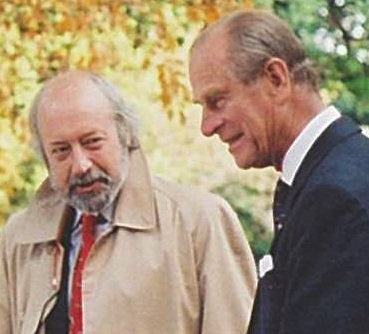Above: Bruce Litteljohn, standing, with the Rhythm Kings orchestra at a Hallowe'en dance at Club Hadamaar,Dalewood Auditorium, Westdale, October, 1954. Band members are (l.to r.) Bob Pratt, piano; Andy Hunter, bass; Ron Richards, drums; Jerry Jerome, baritone sax; Wayne Eving, tenor sax; Dave Watson, alto sax; Peter Banting, alto sax; Mike Cavanagh, tenor sax; and trumpets, John Huxley, Penny Baxter, Dave Short.

Left: Bruce Litteljohn consorts with a consort
Bruce Litteljohn, a fine trombone player, died peacefully on Sunday, 21st September, 2014. Bruce created and was leader of The Rhythm Kings big band at Hamilton's Westdale Secondary School in 1954 and led the McMaster Jazz Septet at University. He was a Master at Upper Canada College, an award winning professional photographer, a wildlife enthusiast and naturalist, and retired to Bracebridge, Ontario.
Born in 1935, Bruce Litteljohn (aka. Sam, Li'l Sam, Camel Driver) was a man of many talents and passions. His talents included skillful writing, excellent photography, trombone virtuosity, and leadership. His passions included love of the wilderness and nature, music, his garden, scholarship, beautiful women, and Shasta, the wonder dog.
Having persevered big city life during his working career, Bruce retired to his beloved Canadian Shield, living in Bracebridge. He had two sons and a daughter.
As a leader, when Bruce set a goal to achieve, his attitude reflected a “damn the torpedoes, full steam ahead” determination. Bruce made things happen, and won the respect of many because of this. In high school and university, he forged a 13-piece orchestra into a big band of note. Not even the principal of Westdale Collegiate could hold Bruce down. On one occasion in a face-to-face confrontation, Bruce told the principal: “You should have been drowned at birth.” Bruce also confronted the Musicians’ Guild on a couple of occasions when he felt the band was being treated unjustly.
A fine musician and versatile ad-libber (as long as the music was in the key of Bb), in his learning years Bruce travelled 80 miles weekly to study trombone in Toronto. He led the “Rhythm Kings” big band in high school, a jazz orchestra at McMaster, and smaller ensembles in summers at a Muskoka resort. He took his seven piece small band on a Holland America North Atlantic cruise ship to Germany and back. And he produced an LP recording. In 1999, when his long-time pal and former lead alto player started the Peter Banting SWINGTET, Bruce generously provided his old Septet charts that had been arranged by Johnny Macdonald.
Bruce's determination helped him academically to complete his B.A. (McMaster), M.A. in History (U.B.C.), and B.Ed.(U of T), to earn scholarships, to achieve Dean’s Honour List, and to become a University Fellow (U.B.C.). His career encompassed 35 years corrupting the impressionable minds of students at Canada’s most prestigious Prep School and training ground for the country’s future leaders of government and industry, Upper Canada College. He was History and Geography Chairman for 20 years. He also created and for 15 years operated UCC’s Norval Outdoor School.
Bruce’s scholarship extended to coauthoring and contributing to 14 books and numerous journals (including National Geographic and the Globe and Mail).
In the early ‘60s, Bruce had come face-to-face with nature in the raw as a Park Ranger in Quetico National Park. He must have enjoyed portaging heavy loads across the height of land, and conversing with black flies and mosquitos, for he continued to respond to the call of the wilderness during his entire life.
Bruce was a committed environmental conservationist and naturalist researcher, educator and advocate. He became the first Historian with the Parks Branch of the Department of Lands and Forests in 1964. In addition to writing about and photographing the wilderness, Bruce was a director of the Wildlands League for 26 years, and was instrumental in getting Quetico Park designated as a “primitive” park, and making it the first readily-accessible wilderness park in Ontario, not to mention raising hundreds of thousands of dollars for the League. Today Bruce’s wilderness books are considered to be major conservation reference works.
Photographs taken by Bruce Litteljohn have been lauded as “extraordinary brilliance” exhibiting “strong aesthetic sense and control.” They portray the wilderness, jazz musicians, and artistic figure studies. He has taken wildlife assignments in Zambia, production stills for commercial films, and work for NFB, Oxford University Press and other clients. His prints have participated in touring exhibitions and hang in public galleries, private and corporate collections. Bruce also taught photography at the Algoma School of Fine Arts.
This site is dedicated to Bruce Ltteljohn, with affection.